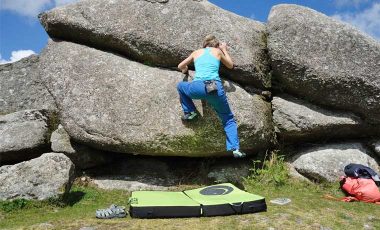Few sports are quite so adept at focusing our priorities as climbing and bouldering. While in tennis we might dream of that 100 mp/h serve, in running that 5-minute mile, and in golf that sub-70 round, for those of us who spend our free time fondling large, inanimate lumps of rock the emphasis is usually placed on staying alive and injury free.
When trad or crag climbing, this is achieved with the help of a belayer and appropriate technical gear; when bouldering, these two saviours of skins are, of course, scarily in absentia.
But it ain’t all left to the luck of the landing. Circa fifty years ago some genius came up with the idea of creating portable mats or crash pads to place under the fall line of inadvertently airborne climbers and spare the whole hassle of that injury and death stuff. In the intervening years, these once rudimentary affairs have developed into surprisingly high-tech products that can make us feel just as safe as those golfers and joggers out for their daily dawdle. (Kinda…)
Below, we’re going to take a look at the best bouldering crash pads (or best bouldering crash mats, depending on which side of the Atlantic you’re on) on the market in 2024. For those wanting to know more about bouldering pads and mats, skip to the bottom of the article where you can read tips and insights to help you figure out what you need when searching for the best crash pads for bouldering.
Read on, stay alive, skip the injuries, climb happily ever after!
The best crash pads for bouldering in 2024
Disclaimer: We use affiliate links and may receive a small commission on purchases.
| Product | Features | Dimensions | Weight | Cost |
|---|---|---|---|---|
| OG Kush Bouldering Pad | Made with eco-friendly materials | 36 x 48 x 4.5 inches | 11lbs | $$$$$$ |
| Edelrid Mantle III Crash Pad | Versatile, durable, portable | 43 x 46 x 4 inches | 11.4lbs | $$$$ |
| Metolius Session II Crash Pad | Portable, good value | 36 x 48 x 4 inches | 9lbs | $$$ |
| Mad Rock R3 Crash Pad | Baffled design good for uneven ground, durable | 35 x 55 x 4 inches | 20lbs | $$$$ |
| Black Diamond Drop Zone Crash Pad | Excellent foam layering for protection, lightweight | 41 x 48 x 3.5 inches | 9.5lbs | $$$$$ |
| Organic Climbing Simple Pad | Comfortable to carry, portable | 36 x 48 x 4 inches | 12lbs | $$$$ |
| Petzl Alto Crash Pad | Excellent protection, durable | 39 x 49 x 5 inches | 13lbs | $$$$$$ |
| Asana Hero Bouldering Crash Pad | Very comfortable to carry, portable | 36 x 48 x 4 inches | 12lbs | $$$$ |
| Mad Rock Mad Pad | Great value, excellent protection | 37 x 50 x 5 inches | 13.8lbs | $$$$ |
| Metolius Shortstop Crash Pad | Adds extra cushioning to an existing pad | 23 x 36 x 0.75 inches | Not available | $ |
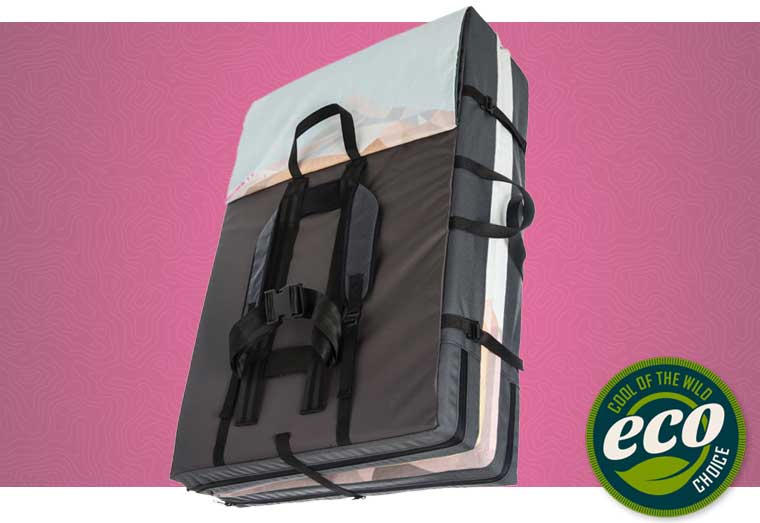
O.G. 2 Kush Crash Pad
The O.G. 2 Kush Crash Pad is one impressively eco-friendly bouldering pad. So much so that Kush Climbing claim that it is the world’s first crash pad built with sustainability in mind. We love that they’re shouting about it — it sure makes things easier for us consumers. And looking at the fabrics and practices used to create the pad, we’ll give them that claim! Here’s why…
- Hemp top sheet: There are no herbicides or pesticides used to grow hemp. Hemp is also mega durable and is one of the most sustainable fabrics on the planet.
- Regen nylon ground sheet: Made from 100% recycled nylon twill woven fabric that is created using discarded fishing nets.
The hinged pad also has comfortable shoulder straps, metal fasteners and an all-important 4.5 inches of 3-layered foam protection to soften your falls on low to mid-height bouldering problems.
Pros
- Excellent foam layering for protection
- Good size
- Fairly Lightweight (11lbs)
- Super durable
- Includes groundsheet
Cons
- Made to order – so may take a little longer to get hold of
- No storage pockets
- Pricey
Find the latest price at:
Kush Climbing
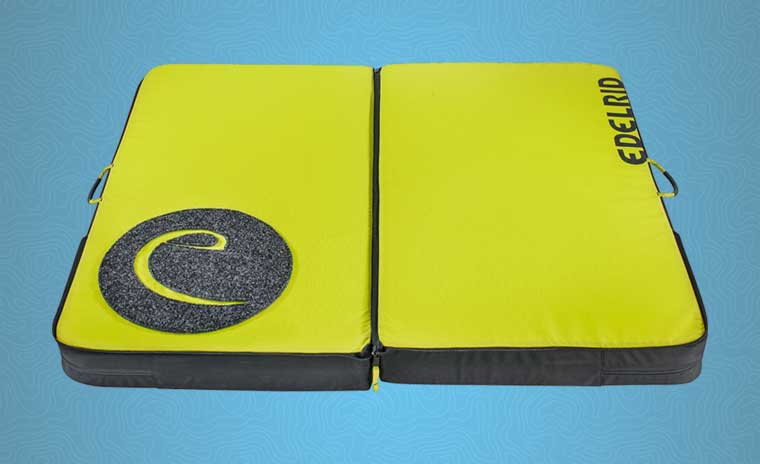
Edelrid Mantle III Crash Pad
New in 2019, the Edelrid Mantle III Crash Pad is a superb option for boulderers who are partial to a short hike into their project. At only 11.4lbs (5.2kg) it’s a super lightweight carry, especially considering it’s very respectable size (4 x 43 x 46 inches). Though not quite large and thick enough for serious highball problems, the improved 4-layer PE + EVA foam padding provides reliable shock-absorbency for all-round bouldering. Plus, the unique folding design unzips almost completely for use as a long, narrow mat (87 x 24”) as well as it’s usual configuration.
This highly durable mat has an adjustable backpack carry system which provides reasonable carrying comfort, though not as plush as the Organic Climbing Simple Pad. Additionally, there are recycled rope carry handles on three sides of the mat, and a carpeted section for politely wiping your feet before each ascent!
For more information read our full review of the Edelrid Mantle III.
Pros
- Can unzip the halves to make mat long and narrow
- Good size
- Lightweight
- Super durable
- Integrated foot mat
- Three handles facilitate relocation when circuiting
Cons
- Shoulder straps not the most comfortable
- No storage pockets
Find the latest price at:
Rope Locker | Edelrid
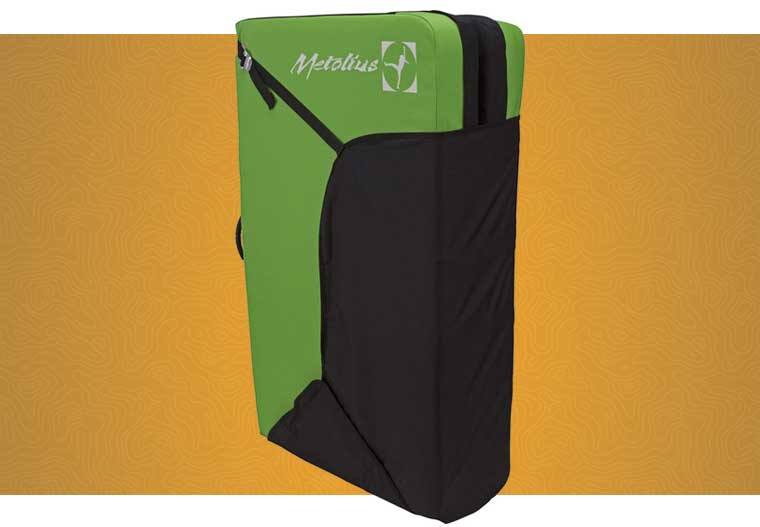
Metolius Session II Crash Pad
Those in the market for a cheap, entry-level crash pad that’s as easy on the back when carrying as it is on the bank balance could do worse than add the Session II to their shortlist.
Measuring 36 x 48 x 4 inches, the Session II isn’t going to win any prizes for surface area or thickness, but offers just enough of both to make it a solid choice for beginners and taking on lowball problems. At just 9 lbs, moreover, this is a good option for those who see themselves putting in a bit of trail time before reaching their rocks.
On the downside, this pad uses relatively soft foam layers and that, combined with the slightly skinny 4” girth, is unlikely to fill you with confidence if you’re venturing too high off the ground.
Pros
- Reasonably priced
- Low weight (9lbs) makes it a good option for those who need to put in some trail miles before
reaching their rocks - Very handy built-in carpet for cleaning shoes
- Two handles facilitate relocation when circuiting
- Ideally suited to lowball beginners or those venturing far from the car park before getting their boulder on
- Nice padding on shoulder straps
Cons
- Not the most durable
- Only 4”thick (suitable for lowballing only)
- Soft foam means there’s a higher chance of bottoming out
- Lacks padding on hip belt
Find the latest price on:
Amazon | REI | Backcountry

Mad Rock R3 Crash Pad
Eco-conscious: Filled with recycled foam
The list of ‘pros’ and ‘cons’ below will quickly reveal that the Mad Rock R3 has a lot going for it. The R3 is the quirky member of the crash pad family, featuring a tube-like design of 7 baffles that get around that age-old problem of setting your mat down evenly, untilted, on uneven ground.
Additionally, at 35 x 55 x 4 inches, the R3 offers a large landing zone compared to most competitors in its price range. And, although only 4” thick, the closed and open-cell foam combo is far more effective at preventing bottoming out than many other 4” models. Another lovable feature in the R3 is its portability. The adjustable, padded straps and hip belt make it one of the most comfortable carries in our review and the baffled design — which holds gear better in the fold — along with MOLLE-style webbing on the exterior make it great for lugging gear.
There are few downsides to the R3, but its somewhat ponderous 20-pound weight will possibly prove to be a stumbling block for anyone venturing too far from the roadside before hitting the rock.
Pros
- Ideal for uneven surfaces – baffled design allows it to conform to the contours of the terrain beneath your boulder
- A lot of pad for your money
- Great gear-carrier
- Tough, durable materials (1680 denier nylon)
- Large surface area
- Secret snack pocket included!
- Fully adjustable and well-padded shoulder and hip straps
Cons
- Heavy (20 lbs)
Find the latest price on:
Amazon | Backcountry
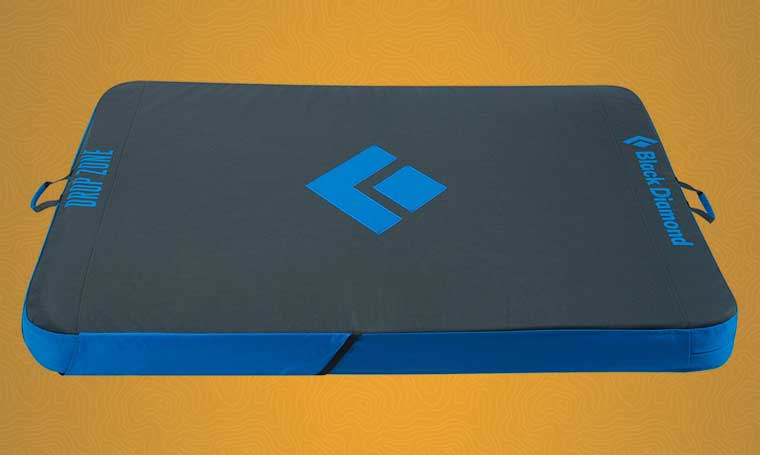
Black Diamond Drop Zone Crash Pad
The name ‘Black Diamond’ and quality tend to go hand in hand and the Drop Zone crash pad is no exception. While a little short on girth, the Drop Zone makes up for this failing with very effective foam layering, an easy carry weight, and an overall quality of construction that all but ensures you won’t be needing to make a re-purchase any time in the near future.
While we would have liked just a little more thickness and a slightly smaller figure on the price tag, the Drop Zone is a very convenient, well-made pad that bridges the gap between entry-level models and the lower end of highball models.
A good choice for those in the market for a lightweight pad offering heavyweight performance.
Pros
- Light (9 lbs 8 oz)
- Reasonably large surface area (41 x 48”)
- Mesh flap for shoe storage
- Rubber-coated bottom stops pad slipping
- Duo of handy drag handles
- Effective foam layering makes up slightly for the lack of girth (closed-cell PE foam layer up top, high-compression PU foam on the bottom)
Cons
- Pricey per square foot of surface area
- Only 3.5” thick
Find the latest price on:
Black Diamond | Backcountry

Organic Climbing Simple Pad
If frill-free efficiency is your thing, the Organic Climbing Simple Pad might just be the pad for you. As the name suggests, this pad doesn’t mess around with too many add-ons, but takes care of business with a fairly stolid, lightweight, highly portable protective bulwark that measures in at a very respectable 48 x 36 x 4 inches.
At 12 pounds, this pad is light enough for lengthier carries. It boasts a very comfortable, adjustable strap and suspension system that makes those annoying pre-climb A to Bs far easier than with other models in its price range such as the Mad Rock Mad Pad (below). It isn’t the most stylish out there. But for those looking for a well-made, reliable, durable, affordable pad that’s suitable for long approaches and yet holds its own with thicker, heavier pads made for roadside bouldering, this one deserves a place on your shortlist.
Pros
- Light (12 pounds)
- Reasonably priced
- Effective foam padding
- Very comfortable to carry
Cons
- Lack of storage pocket (s)
- A little on the thin side for highballing
Find the latest price at:
REI
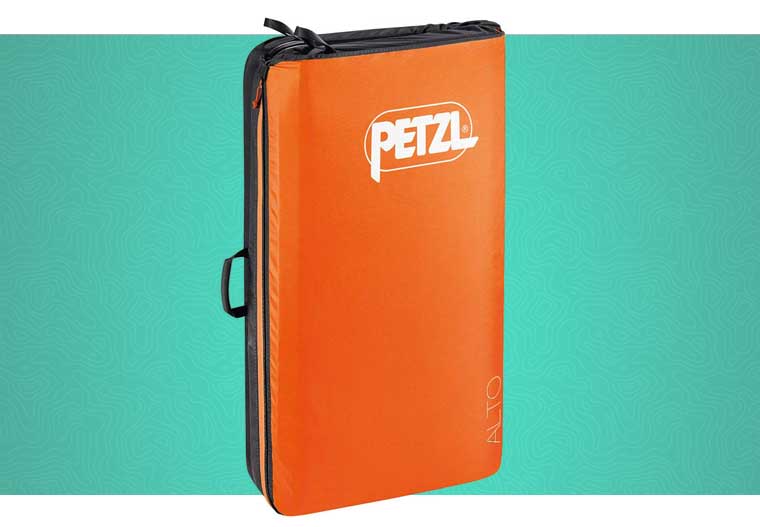
Petzl Alto Crash Pad
For those with money to burn or just especially keen to get their hands on one of the most convenient, well-made, and feature-rich crash pads out there, we’d highly recommend throwing the Petzl Alto onto your shortlist of potential purchases.
This pad features three layers of foam of varying densities, a hingeless (and, hence, gap-free) design, waterproof and durable materials, and a zippered flap closure that makes carrying all your gear far easier than with almost any other pad on our list. Add to that it’s meaty 5” thickness and surface area of 39 x 49 inches, and you’re looking at what’s got to be one of the best all-rounders your money can buy.
Sure, the price might cause a gulp or two at the outset and highballers may balk at the requirement of taking fairly precise “aim” before falling, but in terms of overall functionality and all-round performance the Alto is hard to beat.
Pros
- Three layers of foam offer great protection
- Hingeless design means there’s no potential “gap” in the fold
- Reasonably light (13 pounds)
- Zippered closure allows you to carry gear without fear of losing anything
- Measure 39 x 49 x 5 inches
- Uses tough, durable, waterproof fabrics that are reinforced in key areas
Cons
- (Darn) pricey!
- Carry straps not adjustable to torso length
Find the latest price on:
Amazon | Backcountry
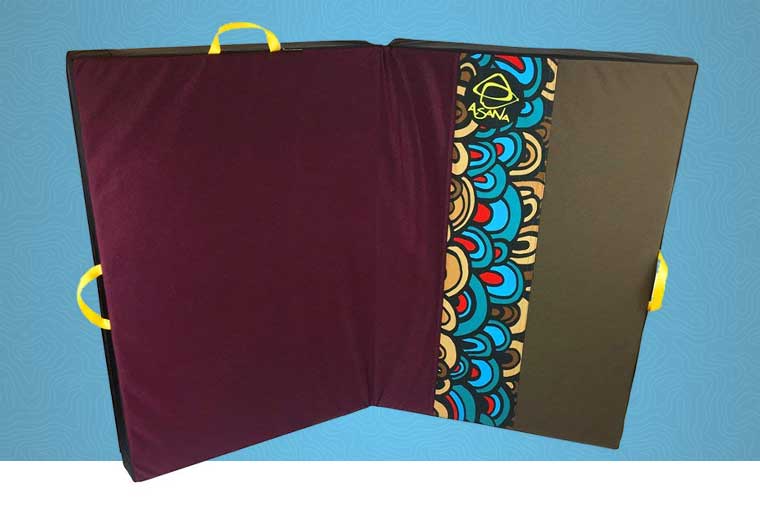
Asana Hero Bouldering Crash Pad
If you like to do your bouldering with a little bit of flair, the Asana Hero might just be the pad for you! This very stylish pad isn’t all about the looks, however. Using 1000 denier nylon with bottom and side flaps, the Hero is a hard-wearing workhorse that’s built to last. This pad also features a “Deluxe Suspension System”. This system includes contoured padded shoulder straps, load lifting straps, a sternum strap, and a padded waist belt, all of which combine to make it one of the most comfortable carries we’ve come across.
On the downside, the Hero isn’t overly heroic in terms of cushioning. While marketed as a “highball” crash pad, in reality we’d feel a little uneasy about venturing too far off the ground or out of our comfort zone with such a small (relative to other highball models) and thin pad below us.
Pros
- Very stylish
- Awesome strap and suspension system make it very comfortable to carry
- 2 inches of open-cell and 2 inches of closed-cell foam combo effectively buffers falls from lower
heights - Three carry handles
- Lightweight (12 lbs)
Cons
- Pricey
- 4” thickness doesn’t inspire confidence when 3+ meters up
- Not waterproof
Find the latest price on:
Amazon | Asana Climbing
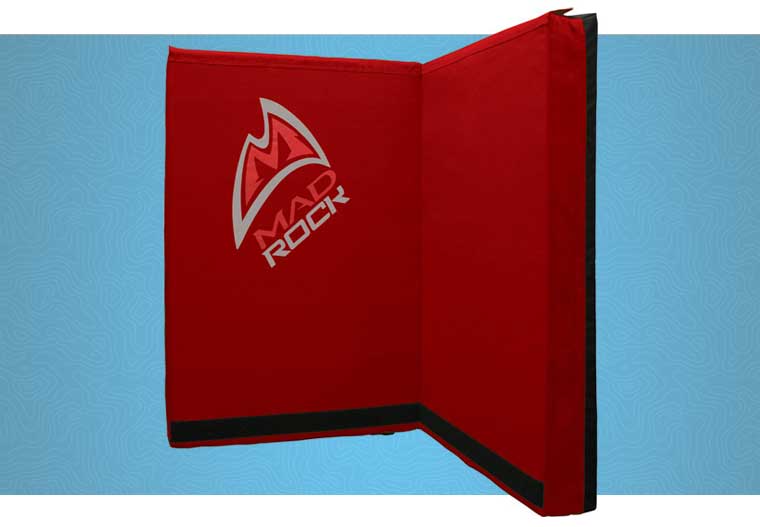
Mad Rock Mad Pad
Cheap crash pads for bouldering don’t come much better than the Mad Rock Mad Pad. The coloring of this pad might not appeal to everyone’s tastes, but for those more concerned with functionality and that whole death-and-injury avoidance business mentioned above than appearances, it’s a winner.
Measuring in at 37 x 50 x 5 inches, the Mad Pad is thick enough to effectively cushion slightly higher falls than the Organic Simple Pad, the R3, or the Metolius Session II, and that 50-inch width buys you a little more leeway when heading landward.
This pad isn’t waterproof and the materials used aren’t the most durable, but in terms of value for money it leaves most competitors trailing in its wake.
Pros
- 5” thickness
- Cheap!
- 50” width
- Relatively light (13.8 lbs)
Cons
- Materials not very durable
- Shoulder straps a little uncomfortable
- Foam loses springiness with time
Find the latest price on:
Amazon | Backcountry

Metolius Shortstop Crash Pad
A bit of a wildcard entry in our list, the Metolius Shortstop is a very handy gap-filler or buffer-boosting backup that can make a big difference when used in conjunction with your regular crash pad. At 36 x 23 x 0.75 inches, you wouldn’t want to use this pad on its own, but slip it over or under your main pad or in any uncovered area to the side and it provides a little extra (but very much appreciated) peace of mind.
Pros
- Very cheap
- Ideal for adding cushioning to your existing pad
- Light
- Handy for covering rocks just out of the area covered by your main pad
Cons
- Not suitable as a stand-alone pad (only 0.75 inches thick)
Find the latest price on:
Amazon | REI | Backcountry
What to look for in a crash pad for bouldering
Before rushing off to buy your crash pad, there are a few key considerations that will help ensure you get the best and most suitable model for the type of rock-hugging you get up to. Below, we’ve highlighted the most important of these factors and include a word or two on how to choose between different varieties.
Category and size
The size of your crash pad is one of the most important factors to take into consideration when buying. If you think of yourself as a small, fuel-less airplane and your pad as the impromptu landing strip, it’s fairly self-explanatory that the bigger the pad you plump for, the more likely you are to avoid any mishaps when you find your fingers grasping at thin air.
If you’re the type of boulderer who spends a lot of time working on short, testy problems in a confined area, then a regular-sized pad will probably have you covered. However, if you’re not a fan of all this “probably” business when it comes to discussions of your well-being, or are likely to be doing your climbing roadside and don’t have to carry your mat too far, then opting for a pad with a larger surface area and more girth becomes an option. And perhaps advisable…
Another consideration when deciding on the size of your crash pad is the height you plan on scaling to. If you’re taking on problems that don’t venture above the 3-meter (or ten-foot) mark, then you’ll probably get away with (and feel comfortable enough) using a standard pad boasting 4 inches of girth. If highball bouldering is your thing, however, a meatier pad with at least five inches of depth and a more sizable landing area is a wise choice.
While different brands vary their sizing, the list below will give you an idea of the ballpark figures involved in crash pad sizing:
Regular: Around 35 x 40 inches when unfolded, 4 inches thick, and with a surface area in the region of 12-14 feet. Commonly, these pads are intended for entry-level use, circuits, problems that don’t take you too far above terra firma, and are frequently used in combination with another regular pad to boost surface area or cushioning.
Full: Above 38 x 45 inches when unfolded, 5 inches thick, and with a surface area between 14 and 20 feet. These pads fall into the ‘intermediate’ class of usage for boulderers who’ve been broken in on lowball problems and fancy stepping things up a notch by moving into that airier grey area between lowballing and highballing. Full pads can go either way in terms of portability, i.e. light and very portable or heavy and not so portable.
Oversized: Above 45 x 60 inches when unfolded, 5/6 inches thick, and with a surface area between 18 and 25 square feet. These pads cost a small fortune, are heavy, will seriously impinge upon the storage space in your tool shed or closet, and might require the purchase of a new car to accommodate. But for highballing, “frequent fliers”, or those who simply want added peace of mind, these potential failings become all the more tolerable. In short, if you’re taking on anything high and hard, one of these beasts is what you want to have below you.
Backup/supplemental: These pads come in a variety of sizes and, as the name suggests, are not intended for stand-alone use. So, why might you want one? Well, for starters, for the more cautious climber they can give the added peace of mind that an added inch or two of thickness brings — throwing one of these on top of your standard pad is, we suppose, like adding the veg to your meat, or, in more outdoorsy terms, wearing a liner glove beneath your winter mitts: far from being overkill, it’s best viewed as a complement to Plan A.
Secondly, if you and your bouldering buddies have pooled pads beneath a problem and are concerned that a fast-falling ankle might make its way between the gaps in the pads, one of these slim (they usually measure a max of 2 inches) supplements could well be your saviour if placed over the exposed area.
Finally, if you’re taking on sitting starts but don’t want to a) give yourself a five-inch head start with a thick pad, and/or b) don’t want to muddy your backside with potential Instagram-worthy snaps in the offing, then this type of pad can be slipped under your posterior to keep both your posterior and your conscience clean.
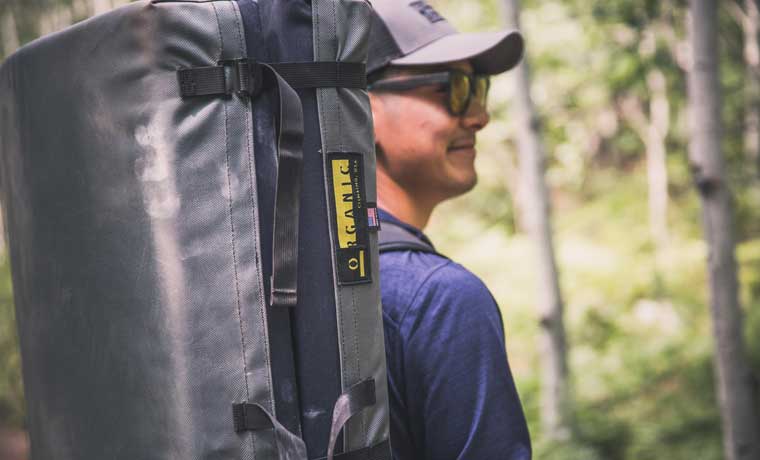
Weight
As with any outdoor gear item, choosing a bouldering mat usually results in accepting some form of trade-off between weight and other desirable features. In this case surface area, thickness, portability, and maybe even durability.
Before buying, asking yourself a few questions will simplify the selection process by helping you define your priorities and your parameters weight-wise:
- Am I likely to be walking long distances before reaching the spot where I’ll be climbing?
- How many or which other factors am I willing to compromise on to get a lighter pad?
- How much am I willing to compromise?
- Is durability likely to be an issue where I do most of my bouldering?
- Are the boulders I’ll be climbing high enough to warrant an oversized pad?
- Will I climb with the same confidence knowing I have a smaller and slimmer pad?
Pad thickness
This one is fairly simple. The bigger the falls you might be taking, the thicker the pad you’ll need to do the breaking (of the fall, that is…not we hope, any body parts.) As a general rule, we’d aim for no less than 5” for highball problems and only go as low as 3” when climbing well within your capabilities or with a potential drop height of under 2 meters.
In addition to thickness, the other key factor contributing to a pad’s ability to give you a safe landing is…
Foam/fill type and format
The two predominant types of fill inside bouldering crash pads are open and closed cell varieties of foam. Closed-cell foam padding is, as the name suggests, sealed around the exterior and as such is much firmer than open-cell varieties due to the restricted air flow through the cells, particularly upon impact. What this means for you is that when you hit the mat the foam has less “give” and is more likely to prevent you from bottoming out. Open-cell foams, on the other hand, offer far more bounce because the cells permit airflow in both directions, in and out, thus making the landing a little softer but also meaning you’re more likely to bottom out.
The majority of crash pads on the market offer the best of both worlds by combining both closed and open cell protection in a duo or trio of layers. When buying, be sure to check this is the case with your potential crash pad purchase — if it isn’t, we’d highly recommend looking elsewhere.
Portability
As anyone who has ever slugged an ill-fitting or poorly made backpack over miles of trail knows, portability is not only about weight. As with backpacks, the configuration and quality of the carry straps and suspension system play just as big a part in your overall comfort when lugging a load. Some models of crash pad excel in this regard, others less so.
If you plan on carrying your pad relatively long distances before getting your boulder on, we’d recommend plumping for a pad that falls into the “excels” rather than the “less so” category. In short, this means fully adjustable, padded shoulder straps, a padded hip belt, and ideally a sternum strap to centralize and stabilize your load and thus improve balance.
Additionally, certain crash pads out there come with small bonus features such as zippered closures and pockets. These let you carry additional gear without worrying about it slipping out of the interior or fold of your mat while you’re on the move — very handy for anyone who doesn’t have a second back or set of shoulders to sling a backpack containing their extra kit over.
From super-slim supplementary pads to chunky highball drop-stoppers, in the above review we’ve seen a bit of it all! While the pad that’s right for your rock-hugging sessions will ultimately depend on what type of rocks you’re hugging, how well you hug them, and how far you have to travel to do your hugging, our list of this year’s best bouldering crash pads is sure to contain at least a few options that will maximize your chances of a happy (and safe!) landing when you find yourself hugging fresh air.
Happy (rock) hugging, people!


